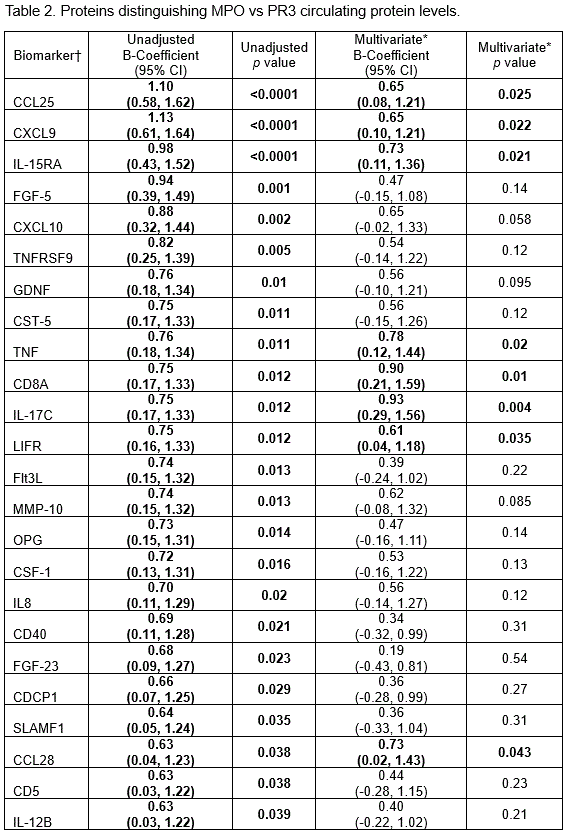Session Information
Session Type: Poster Session C
Session Time: 10:30AM-12:30PM
Background/Purpose: ANCA type (e.g., PR3-, MPO-ANCA) may be a better way to subgroup patients with ANCA-associated vasculitis (AAV) than phenotype (e.g., granulomatosis with polyangiitis [GPA]). There are important differences in manifestations, treatment responses, and outcomes in MPO- vs PR3-ANCA+ AAV, but biological differences that may contribute to these observations are not well understood. Identifying circulating proteins that differentiate PR3 and MPO subclasses of AAV may highlight biological mechanisms underlying these observations and identify specific treatment targets. Our goal was to identify circulating proteins that differentiate active MPO- vs PR3-AAV.
Methods: Serum samples from participants with MPO- or PR3-ANCA+ AAV were retrieved from an ongoing prospective cohort study. The levels of 92 circulating proteins were measured using the Olink inflammation proteomic assay. We included patients with active (BVAS v3 >0) MPO- or PR3-ANCA+ AAV at sample collection. Patients with eosinophilic GPA were excluded. Details of demographics, medical history, and organ involvement were extracted from electronic health records and survey responses. After normalizing protein levels, we used unadjusted and age, sex, and steroid usage-adjusted linear regression to compare levels in MPO- vs PR3-ANCA+ AAV.
Results: Of those with proteomic data, we identified n=38 (66% female, median age 57) with active disease; 20 were PR3-ANCA+ and 18 were MPO-ANCA+ (Table 1). MPO-ANCA+ participants were older than PR3-ANCA+ patients (mean age 66.8 vs 47.4 years, respectively). The most common manifestations were pulmonary (61%), sino-nasal (53%) and kidney involvement (26%). Kidney involvement was more common in MPO-ANCA+ AAV (33% vs 20% respectively) while sino-nasal (44% vs 60%, respectively) and pulmonary disease (50% vs 70%, respectively) were more common in PR3-ANCA+ AAV. At the time of sample collection, the most common treatment in both groups was rituximab (56% vs 55%, respectively). In unadjusted analysis we identified 24 proteins that were significantly different in MPO- vs PR3-ANCA+ AAV (Tables 2, 3). After adjusting for age, sex and steroid use, statistical differences were confirmed in 8 proteins: IL-17C (b-coefficient 0.93; 95%CI 0.29, 1.56), CD8A (0.90; 0.21, 1.59), TNF (0.78; 0.12, 1.44), IL-15RA (0.73; 0.11, 1.36), CCL28 (0.73; 0.02, 1.43), CXCL9 (0.65; 0.10, 1.21), CCL25 (0.65; 0.08, 1.21), and LIFR (0.61; 0.04, 1.18). When we limited our unadjusted analysis to patients on no treatment (PR3 n=7, MPO n=4), CXCL9 (0.97; 0.30, 1.63), IL-15RA (0.76; 0.05, 1.46) and CCL28 (1.14; 0.38, 1.90) differentiated MPO- and PR3-ANCA+ AAV.
Conclusion: We identified 8 circulating proteins that differ in active MPO- and PR3-ANCA+ AAV. Our observations expand on those by Berti et al. (2018) who used a more limited set of proteins and identified 13 inflammatory cytokines that were different in MPO- vs PR3-ANCA+ AAV. Of the 6 analyzed in this study (Table 3), CXCL10 had borderline significance but others did not. These proteins reflect diverse aspects of the immune responses; several are involved in T cell regulation and/or neutrophil function. Further validation of these findings is needed.
† Chemokine C-C ligand 25 (CCL25), chemokine C-X-C ligand 9 (CXCL9), interleukin 15 receptor alpha (IL_15RA), fibroblast growth factor 5 (FGF-5) Chemokine C-X-C ligand 10 (CXCL10), transcription necrosis factor receptor superfamily member 9 (TNFRSF9), Glial cell-line derived necrosis factor (GDNF), Cystatin D (CST-5), transcription necrosis factor (TNF), cluster of differentiation 8 alpha (CD8A), Interleukin 17C (IL_17C), leukemia inhibitory factor receptor (LIFR), FMS-related tyrosine kinase 3 ligand (Flt3L), stromelysin_2 (MMP_10), osteoprotegerin (OPG), colony stimulating factor (CSF), Interleukin 8 (IL-8), cluster of differentiation (CD) 40, fibroblast growth factor 23 (FGF_23), CUB domain containing protein 1 (CDCP1), Signaling lymphocytic activation molecule 1 (SlamF1), Chemokine C-C ligand 28 (CCL28), cluster of differentiation (CD)-5, Interleukin 12 beta (IL_12b)
To cite this abstract in AMA style:
Johnson C, O'Dea D, Atallah N, Reynolds G, Jiang B, Srivatsan S, Williams Z, Wallace Z. Comparing Circulating Protein Profiles in Patients with Active Myeloperoxidase (MPO) vs Proteinase-3 (PR3) Antineutrophil Cytoplasmic Antibody (ANCA) Associated Vasculitis [abstract]. Arthritis Rheumatol. 2024; 76 (suppl 9). https://acrabstracts.org/abstract/comparing-circulating-protein-profiles-in-patients-with-active-myeloperoxidase-mpo-vs-proteinase-3-pr3-antineutrophil-cytoplasmic-antibody-anca-associated-vasculitis/. Accessed .« Back to ACR Convergence 2024
ACR Meeting Abstracts - https://acrabstracts.org/abstract/comparing-circulating-protein-profiles-in-patients-with-active-myeloperoxidase-mpo-vs-proteinase-3-pr3-antineutrophil-cytoplasmic-antibody-anca-associated-vasculitis/



